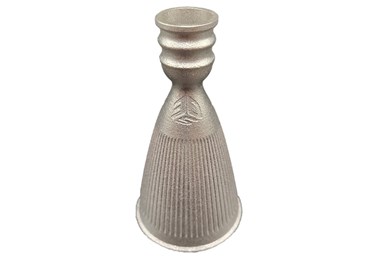3D Systems Develops C-103 Metal Alloy for Challenging Environments
This niobium alloy with hafnium and titanium alloying elements is resistant to decomposition by heat, pressure or chemical attack and thus retains its strength and form at high temperatures.
This niobium-alloy withstands high temperatures and stresses making it well-suited for propulsion applications in space, aerospace, and defense industry applications. Photo Credit: 3D Systems
3D Systems’ Certified C-103 is a metal material with incredible high-temperature strength as well as excellent resistance to vibrations at cryogenic temperatures to deliver parts with exceptional mechanical properties for challenging environments.
C-103 is a niobium alloy with hafnium and titanium alloying elements. It is classified as a refractory material, which is resistant to decomposition by heat, pressure or chemical attack and thus retains its strength and form at high temperatures.
The material has a high service temperature of between 1,200°C and 1,400°C and is capable of withstanding high stresses at those elevated temperatures. Because of its low ductile-to-brittle transition temperature, C-103 has excellent resistance to high-frequency vibrations, making it well suited for rocket, hypersonic and jet-propulsion applications, including spacecraft, satellites and launch vehicles in the space, aerospace and defense industries.
It is specifically designed for high-temperature and high-corrosive operating applications. Parts in C-103 can operate reliably up to a service temperature of approximately 1,480°C. For example, at a temperature of 1,093°C, C-103 has more than double the strength of Ni718 or Ni625.
Specifically, the material is well suited for high-temperature aerospace propulsion and satellite components such as steering nozzles, high-thrust nozzles, thrust chambers, turbine blades, jet engine afterburner flap sections and burst disks test stands components. Other applications include highly corrosive environments, such as chemical processing components.
3D Systems offers application development and part production using the integrated additive manufacturing (AM) workflow software, 3DXpert and the DMP Flex/Factory 350 metal 3D printers. The Certified C-103 parameters were developed, tested and optimized in cooperation with its AS9100/ISO9001 part production facilities, which have printed more than 1,000,000 challenging metal production parts in various materials, year over year.
C-103 was used for the first time in the Apollo-manned lunar module rocket engine in 1965. It has since been adopted for various ultrahigh-temperature applications, such as rocket nozzles, jet propulsion and thrust augmenter flaps. 3D Systems offers this standard alloy now as a solution for AM. The Certified C-103 (A) material is initially offered on the single-laser configurations and is currently compatible with the DMP Flex 350, DMP Flex 350 Dual and DMP Flex 350 Triple as well as the DMP Factory 350 and DMP Factory 350 Dual.
The extremely low oxygen environment of the DMP Flex and Factory 350 vacuum chamber architecture minimizes oxygen pickup, ensuring the best conductivity properties. In effect, the DMP Flex and Factory 350 Architecture enables indefinite storage of C-103 powder under low oxygen conditions. Moreover, with the DMP Factory 350 system, the entire powder handling cycle can be done under an inert environment.
Also, the 3D Systems build volume reducer accessory for the DMP Flex or Factory 350 DMP systems reduces the required amount of powder to load in the printer and allows for cost-efficient pilot application development and pilot production. For companies looking to develop new applications and processes with Certified C-103, 3D Systems’ Application Innovation Group can support and accelerate this development.
- Read about 3D Systems’ SLS 300 which enables advanced SLS technology in smaller manufacturing environments. A new Powder Recycling Station (PRS) is an optional accessory available in 2024 which works in tandem with the printer to automatically recycle unused powder currently in the system and mix it with fresh material.
- Learn about 3D Systems’ Accura AMX Resin which withstands harsh thermal environments. The resin material is well suited for the testing of high-temperature components in applications such as HVAC, consumer appliances, motor enclosures, fixtures, mounts, stators, molding/tooling and more.
Related Content
“Mantis” AM System for Spacecraft Uses Induction for Deposition
The metal 3D printing system melts wire without lasers. 30-foot-diameter parts are built on a rotary-feed system that eliminates the need for a large machine frame or gantry.
Read More3D Printed Titanium Replaces Aluminum for Unmanned Aircraft Wing Splice: The Cool Parts Show #72
Rapid Plasma Deposition produces the near-net-shape preform for a newly designed wing splice for remotely piloted aircraft from General Atomics. The Cool Parts Show visits Norsk Titanium, where this part is made.
Read More3D Printed Lattice for Mars Sample Return Crash Landing: The Cool Parts Show Bonus
NASA Jet Propulsion Laboratory employs laser powder bed fusion additive manufacturing plus chemical etching to create strong, lightweight lattice structures optimized to protect rock samples from Mars during their violent arrival on earth.
Read MoreAdditive Manufacturing Is Subtractive, Too: How CNC Machining Integrates With AM (Includes Video)
For Keselowski Advanced Manufacturing, succeeding with laser powder bed fusion as a production process means developing a machine shop that is responsive to, and moves at the pacing of, metal 3D printing.
Read MoreRead Next
3D Printed Polymer EOAT Increases Safety of Cobots
Contract manufacturer Anubis 3D applies polymer 3D printing processes to manufacture cobot tooling that is lightweight, smooth and safer for human interaction.
Read MoreAlquist 3D Looks Toward a Carbon-Sequestering Future with 3D Printed Infrastructure
The Colorado startup aims to reduce the carbon footprint of new buildings, homes and city infrastructure with robotic 3D printing and a specialized geopolymer material.
Read MoreCrushable Lattices: The Lightweight Structures That Will Protect an Interplanetary Payload
NASA uses laser powder bed fusion plus chemical etching to create the lattice forms engineered to keep Mars rocks safe during a crash landing on Earth.
Read More





















